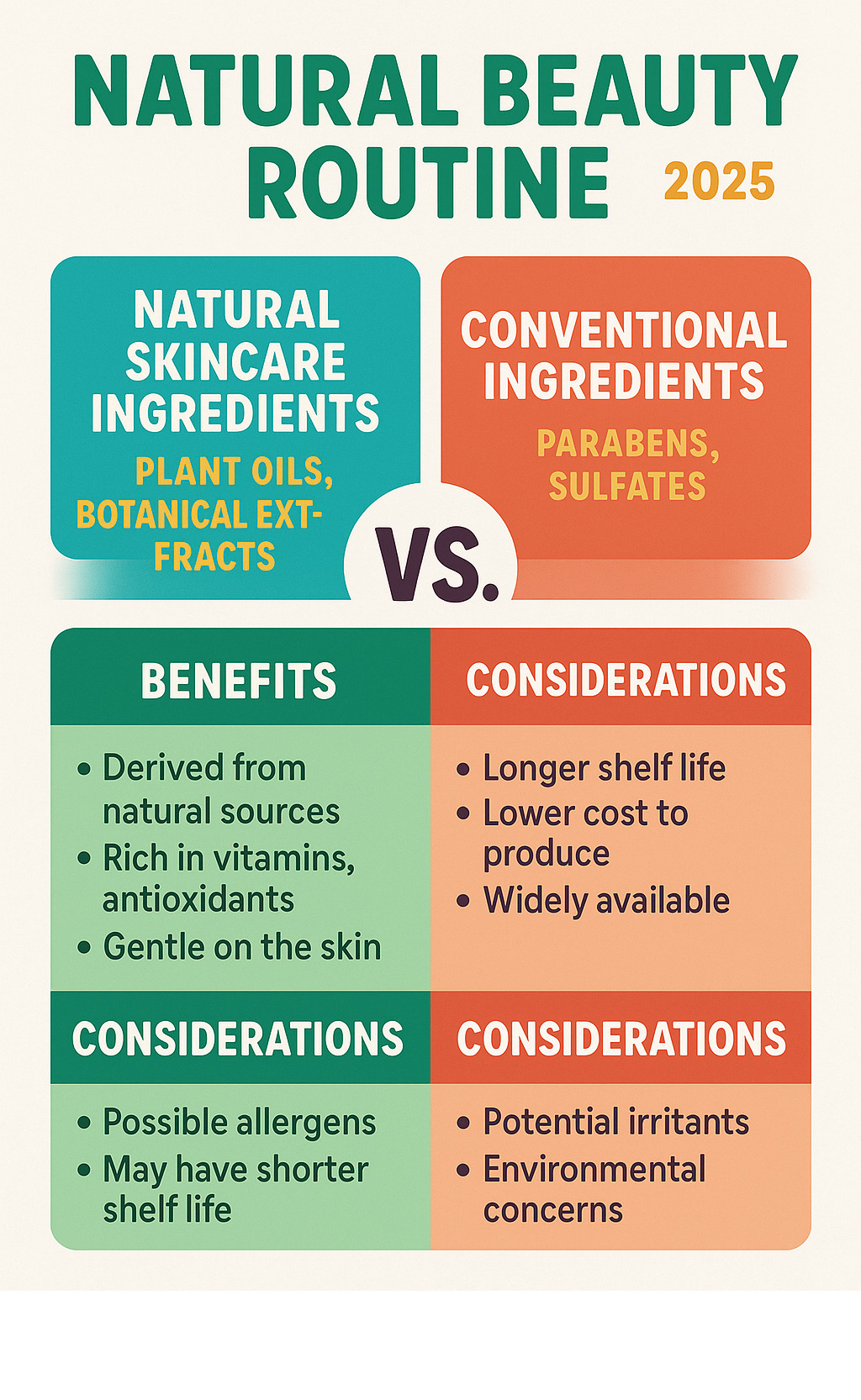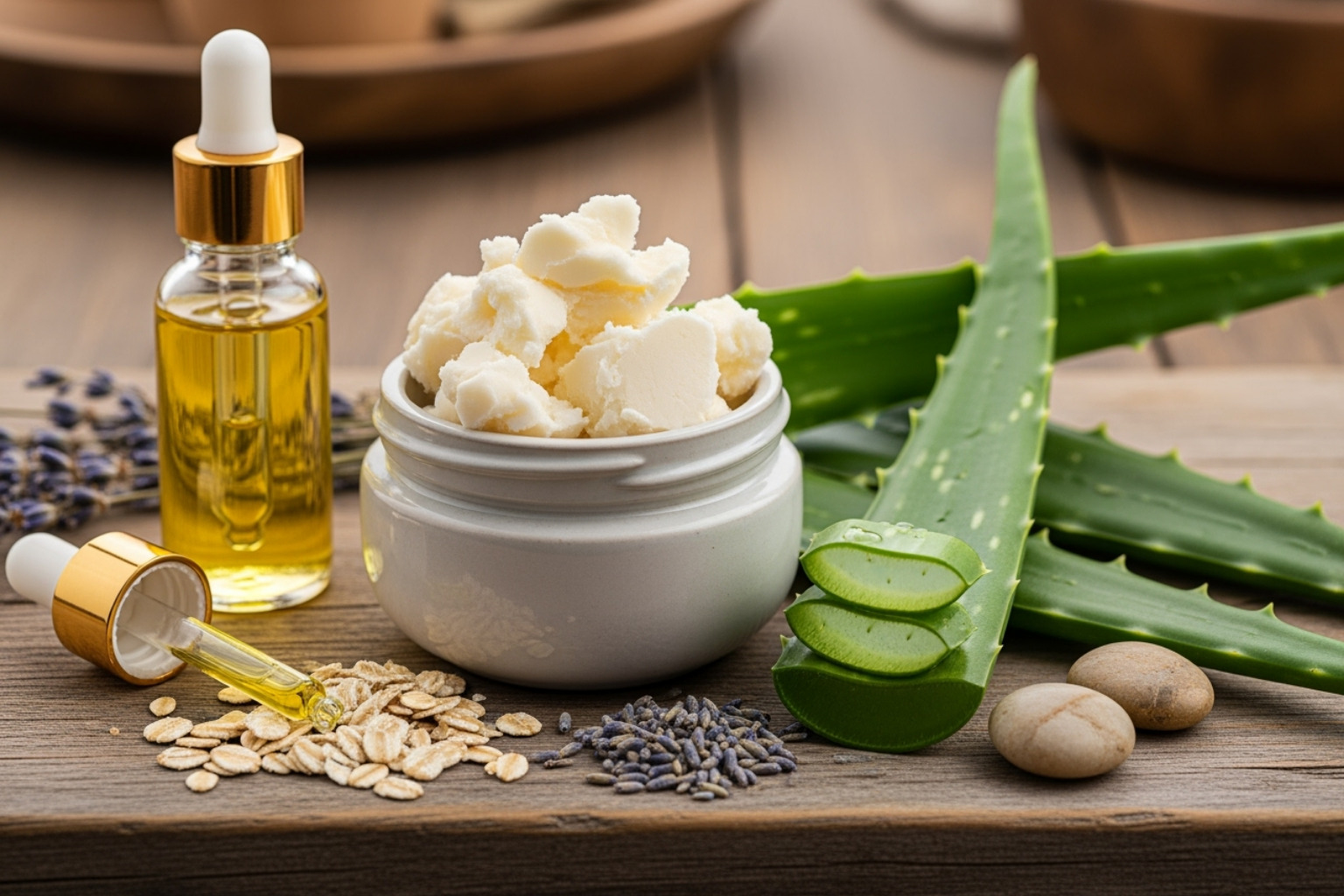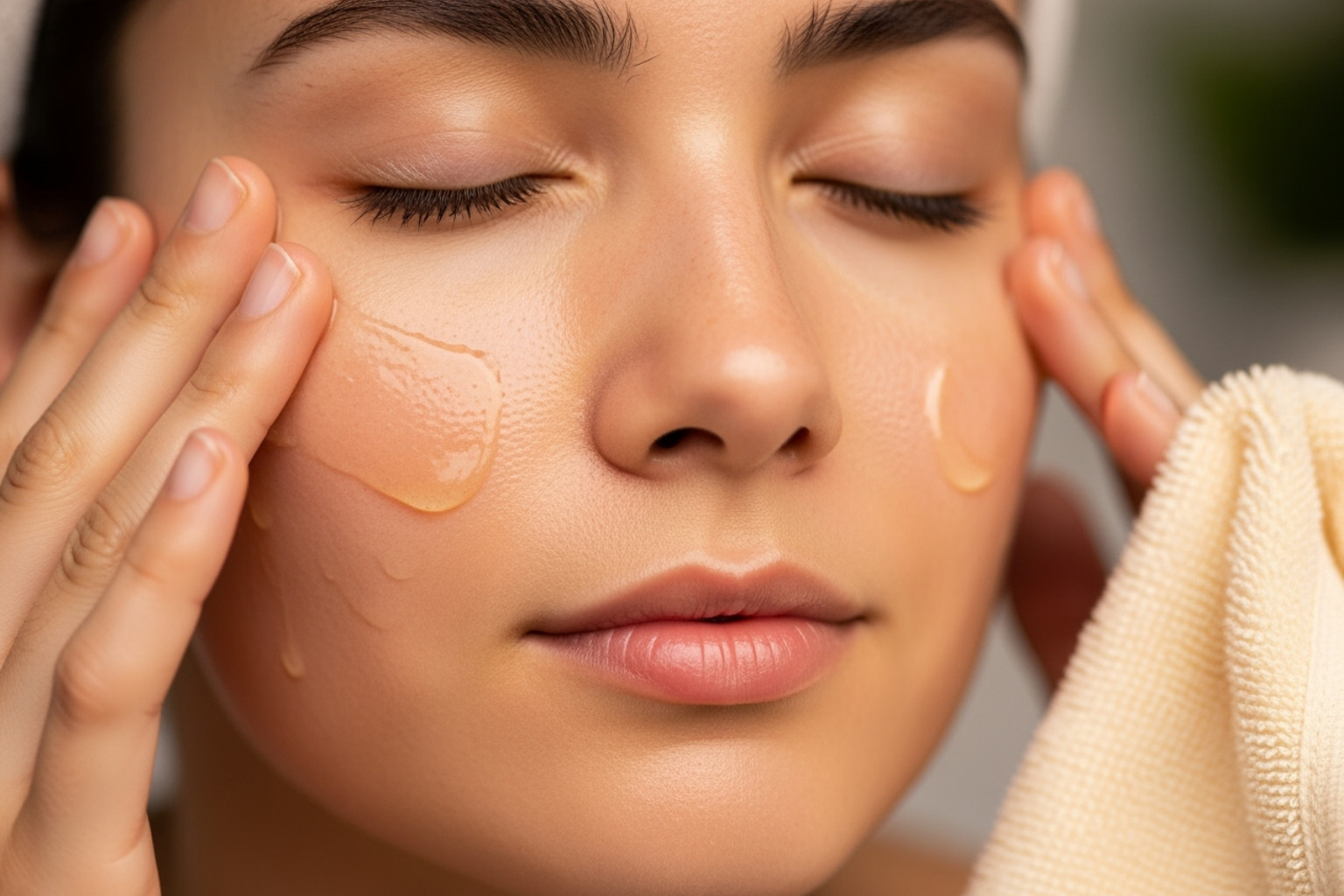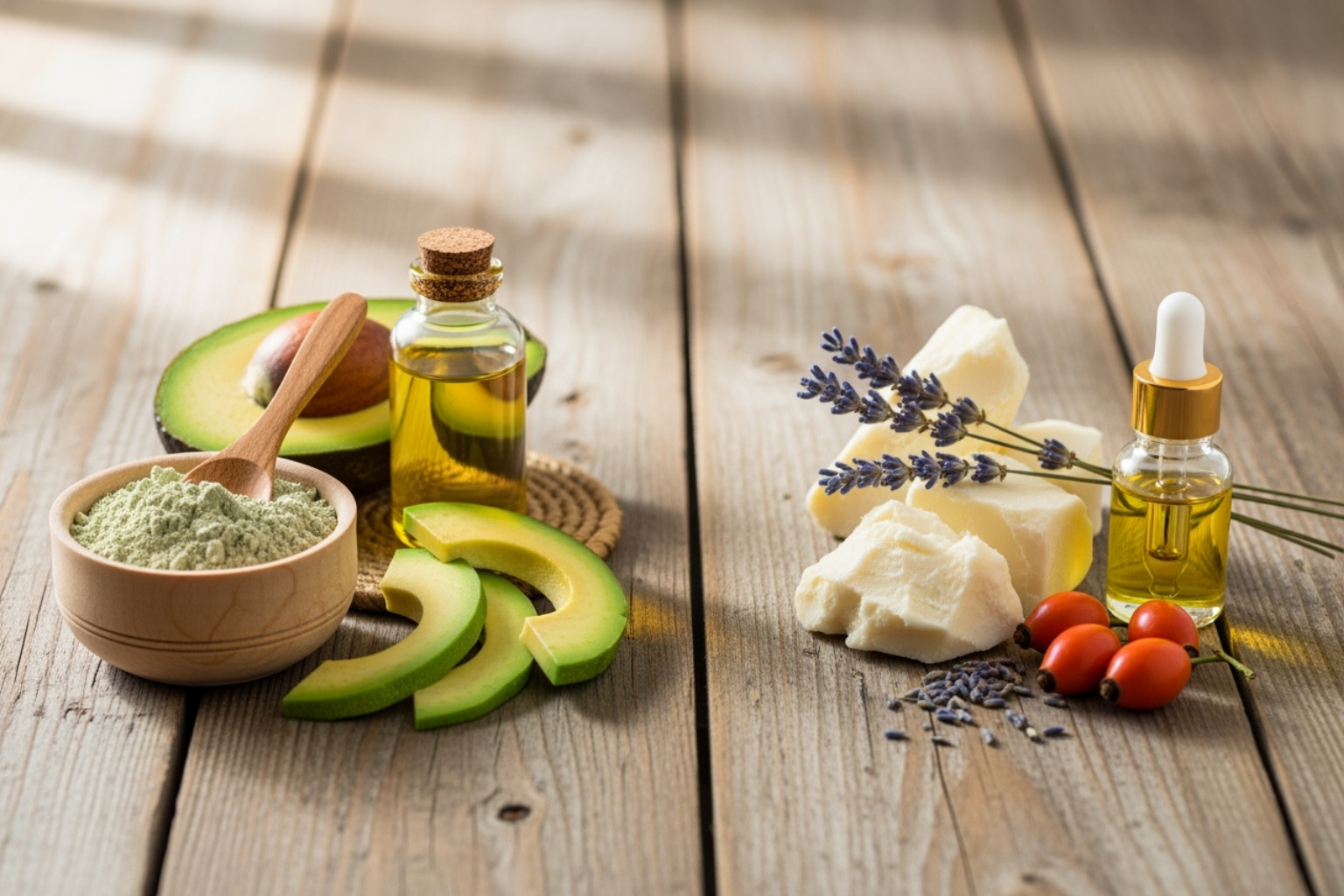Why Natural Beauty Routines Are Changing Modern Skincare
A natural beauty routine uses plant-based ingredients and minimal processing to nourish your skin while avoiding synthetic chemicals like parabens and sulfates. This approach works in harmony with your skin’s natural functions, not against them.
Quick Natural Beauty Routine Essentials:
- Cleanse with plant oils (jojoba, olive oil)
- Tone with herbal waters (rose water, witch hazel)
- Treat with botanical serums (vitamin C, bakuchiol)
- Moisturize with plant butters and oils
- Protect with mineral sunscreen (zinc oxide)
The shift toward natural skincare is driven by a growing awareness of what we put on our bodies. As consumers seek gentler alternatives to commercial products, which often contain chemicals linked to skin irritation, the natural beauty industry has become one of the fastest-growing markets.
Your skin is your body’s largest organ and absorbs much of what you apply. Choosing natural ingredients supports your skin’s overall health and resilience, not just surface concerns. The beauty of this approach lies in its simplicity, focusing on nourishing ingredients like aloe vera, jojoba oil, and shea butter that have been trusted for centuries.

Natural beauty routine vocab explained:
What Defines “Natural” Beauty?
Understanding what makes a natural beauty routine truly “natural” means looking past marketing claims to the ingredients themselves. At its core, natural beauty uses ingredients sourced from nature with minimal processing, creating a gentler approach that works with your skin.
Conventional products often contain parabens, sulfates, phthalates, and synthetic fragrances, chemicals linked to health concerns like cancer and hormone disruption. Natural alternatives use plant oils, botanical extracts, and mineral-based ingredients that have nourished skin for centuries, like jojoba oil that mimics skin’s sebum or soothing aloe vera.
However, the industry lacks regulation for terms like ‘natural,’ ‘organic,’ or ‘clean,’ leading to ‘greenwashing.’ Some ingredients are “nature-identical” – lab-created but chemically identical to natural compounds. To steer this, look for third-party certifications and learn to spot cruelty-free products.

| Feature | Natural Skincare | Conventional Skincare |
|---|---|---|
| Philosophy | Works in harmony with skin’s natural functions, emphasizing nourishment and gentle support. | Targets specific concerns with strong, often synthetic, active ingredients for rapid results. |
| Common Ingredients | Plant oils (jojoba, argan), botanical extracts (aloe vera, green tea), essential oils (use with caution). | Parabens, sulfates, synthetic fragrances, silicones, petroleum-derived ingredients. |
| Environmental Impact | Generally lower due to sustainable sourcing, biodegradable ingredients, and less chemical pollution. | Higher due to chemical synthesis, non-biodegradable components, and potential for harmful runoff. |
| Potential Skin Effects | Gentler, less irritating, supports long-term skin health, slower visible results. | Can be effective quickly, but may cause irritation, disrupt natural skin barrier, or have long-term health concerns. |
Decoding Skincare Labels
Understanding labels is key to your natural beauty routine. Here’s a quick guide:
- Clean beauty is an unregulated marketing term with no standard definition.
- Organic should mean ingredients grown without synthetic pesticides, but look for certifications like USDA Organic or COSMOS to be sure.
- Vegan means no animal-derived ingredients (like honey or beeswax), but doesn’t automatically mean natural or cruelty-free.
- Cruelty-free means no animal testing. Verify with logos from organizations like Leaping Bunny.
- Fair-trade is a regulated certification ensuring ethical sourcing and fair labor practices.
When scanning ingredient lists, long, unpronounceable names often signal synthetic compounds. Learning to spot culprits like parabens and sulfates is a key skill.
The Benefits for Your Skin and Health
Adopting a natural beauty routine offers benefits beyond the surface. By avoiding harsh chemicals, natural products are gentler and cause fewer irritants, making them ideal for sensitive skin.
The nutrient density of natural ingredients is a major advantage. A 2023 clinical review on plant extracts shows botanicals deliver a synergistic blend of vitamins, antioxidants, and bioactive compounds to nourish skin.
Natural skincare supports your skin’s microbiome and barrier function instead of disrupting it, allowing it to heal and function optimally. This approach also helps you avoid potentially harmful chemicals linked to long-term health issues, while often supporting environmental benefits like sustainable sourcing and biodegradable ingredients.
Building Your Step-by-Step Natural Beauty Routine
This section outlines a simple, effective 5-step process for both morning and night, forming the foundation of your journey to radiant skin.
Consistency is key for a natural beauty routine. Natural ingredients work gently over time, so patience is essential. The results are worth it.
Step 1: Cleanse
The oil cleansing method works on the principle that “like dissolves like.” Oil effectively dissolves oil-based impurities like makeup, sunscreen, and excess sebum without stripping the skin. Jojoba oil is excellent because it mimics your skin’s natural sebum, but simple olive oil also works well.
To use: With dry hands, gently massage a small amount of oil onto your dry face. Soak a washcloth in warm water, place it over your face for 30 seconds to steam, then gently wipe the oil away. Pat your skin dry with a clean towel.

Step 2: Tone
Toning balances your skin’s pH, removes any last traces of impurities, and preps skin for moisture. Natural toners are gentle and refreshing. Rose water is hydrating and soothing, while witch hazel is a mild astringent that helps minimize pores. You can also make your own herbal infusions by steeping chamomile or calendula in water. Apply with a spritz or a cotton pad.
Step 3: Treat
Serums deliver concentrated nutrients and antioxidants deep into the skin. For morning, Vitamin C is an antioxidant powerhouse that brightens and helps protect skin from UV damage. For evening, bakuchiol is a gentle plant-based retinol alternative that improves texture and fine lines without the irritation. Apply a few drops to your face and neck.
Step 4: Moisturize
Moisturizing is crucial for locking in hydration and supporting skin elasticity. Natural plant butters and plant oils are perfect for this. Shea butter provides deep moisture, while argan oil is rich in vitamin E. Squalane is another excellent choice that mimics a compound found naturally in our skin. Warm a small amount between your palms before gently pressing it onto your face and neck.
Step 5: Protect (AM Routine)
Sun protection is the most critical step for preventing premature aging and sun damage. Mineral sunscreen with zinc oxide or titanium dioxide is the natural choice. These ingredients sit on top of the skin, physically blocking UVA and UVB rays. They are generally gentler on sensitive skin and provide excellent broad-spectrum protection. Apply generously as the final step in your morning routine.
Customizing for Your Skin: Key Ingredients for a Natural Beauty Routine
The beauty of a natural beauty routine is its flexibility. Understanding your skin type – oily, dry, sensitive, or aging – is the first step to choosing ingredients that will work best for you.

For Oily & Acne-Prone Skin
The goal is to balance oil production without stripping the skin. Tea tree oil offers antibacterial properties but must be diluted. Bentonite and kaolin clay masks are excellent for drawing out excess oil and impurities. Surprisingly, jojoba oil can help regulate sebum because it mimics the skin’s natural oils. Be cautious with coconut oil on the face, as it can be comedogenic (pore-clogging) for some. For specific concerns, especially regarding acne and skin of color, a dermatologist can offer custom advice.
For Dry & Dehydrated Skin
Focus on drenching skin in moisture and locking it in. Hyaluronic acid is a humectant that draws water into the skin for a plump, hydrated look. Aloe vera provides gentle, soothing hydration. For deep nourishment, use rich ingredients like avocado oil, shea butter, and ceramides to help restore the skin’s protective moisture barrier.
For Sensitive Skin
Gentleness is key. Soothe inflammation and strengthen the skin’s barrier. Colloidal oatmeal is a classic anti-inflammatory that calms redness and itching. Chamomile and calendula are botanical extracts known for their soothing and healing properties. Patch testing any new product is non-negotiable for sensitive skin. Be aware that even natural ingredients like essential oils can be irritating, so fragrance-free is often the safest choice.
For Aging Skin
As skin matures, focus on ingredients that support collagen and protect against environmental damage. Bakuchiol is a celebrated plant-based retinol alternative that reduces fine lines without the harshness. Antioxidants are crucial; Vitamin C brightens and protects, Vitamin A helps skin renew itself, and Vitamin E moisturizes and protects. Peptides are amino acid chains that signal the skin to produce more collagen, improving firmness and elasticity.
Beyond the Bottle: A Holistic Path to Radiance
True radiance comes from within, and your natural beauty routine is just one part of the picture. A holistic approach that nurtures your body from the inside out is key to glowing skin.
What you eat directly impacts your skin. A diet rich in antioxidant-rich foods like berries and leafy greens, plus healthy fats from avocados and nuts, gives your skin the tools to fight damage. Hydration is equally important; drinking plenty of water keeps skin cells plump and supple. A healthy gut microbiome, supported by fiber and probiotics, often translates to clearer skin.
Lifestyle factors play a huge role. Quality sleep (7-9 hours) is when your skin repairs itself and produces collagen. Stress management, whether through meditation or a walk in nature, reduces inflammation that can harm skin. Exercise boosts circulation, delivering oxygen and nutrients to your skin cells for that real post-workout glow.
Application matters. Gently massaging products into your skin boosts circulation and lymphatic drainage. Always apply products from thinnest to thickest consistency: cleanser, toner, serum, then moisturizer. For more detail, the American Academy of Dermatology offers tips on applying skincare in the correct order.
A holistic approach is about creating sustainable habits that support your overall well-being, allowing your natural radiance to shine through.
Frequently Asked Questions about a Natural Beauty Routine
What are the potential drawbacks of natural skincare?
While a natural beauty routine has many benefits, there are a few things to keep in mind. Natural products often have a shorter shelf life because they lack strong synthetic preservatives. There is also potential for irritation, as natural ingredients like essential oils can cause reactions in some people; always patch test new products. Finally, results can be slower to appear compared to conventional products, as natural ingredients work gently to support your skin’s long-term health rather than providing a quick fix.
How can I find affordable natural skincare options?
Going natural doesn’t have to be expensive. Your kitchen is a great source for DIY options like hydrating honey masks or gentle oatmeal scrubs. When shopping, look for affordable brands with simple, recognizable ingredient lists. Another great strategy is to use multi-purpose products. For example, a single bottle of jojoba oil can work as a cleanser, makeup remover, and moisturizer, saving you money and simplifying your routine.
How do I know if a product is genuinely “natural”?
To avoid greenwashing, you need to be a savvy consumer. The most reliable method is to look for third-party certifications from organizations like Leaping Bunny (cruelty-free) or USDA Organic. Next, scrutinize ingredient lists – the first few ingredients should be recognizable plant-based names. Finally, research the brand’s ethics and transparency. Genuinely natural companies are usually proud to share their sourcing and production practices. Understanding terms like “nature-identical” (lab-made but chemically the same as natural compounds) also helps you make informed choices.
Conclusion
Starting on a natural beauty routine is a mindful approach to self-care that honors your skin’s wisdom and your overall well-being. You’ve learned to decode labels, build a foundational 5-step routine, and customize it for your unique skin needs.
True radiance combines this routine with a holistic lifestyle: nourishing foods, proper hydration, quality sleep, and stress management. Natural skincare requires patience, but the reward is healthy, glowing skin supported by gentle, effective ingredients that work in harmony with your body.
Your path to healthy skin is a journey of consistency and kindness to yourself. Trust the process and enjoy the glow.
Ready to dive deeper into wellness practices that support your natural beauty from the inside out? Explore more wellness tips for a radiant life and find how Beyond Beauty Lab can support you on this beautiful journey.







